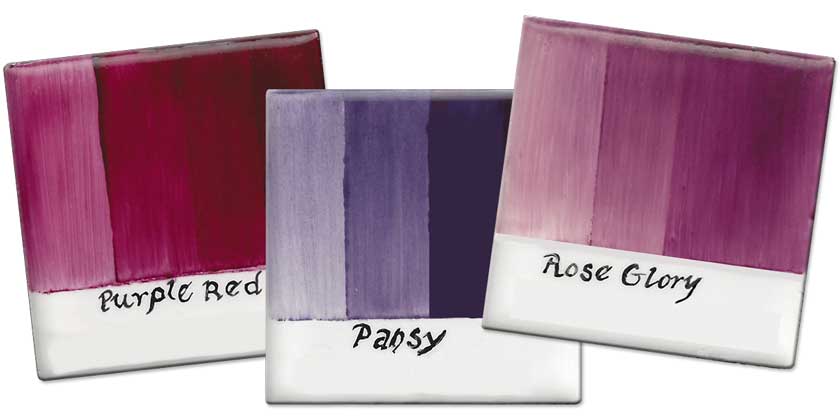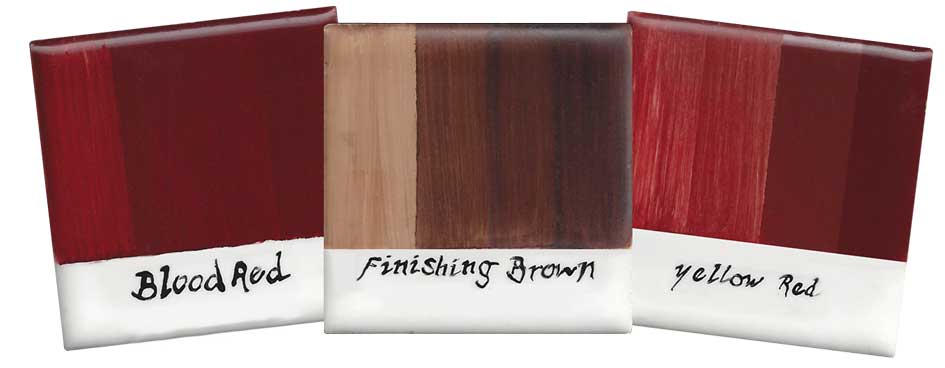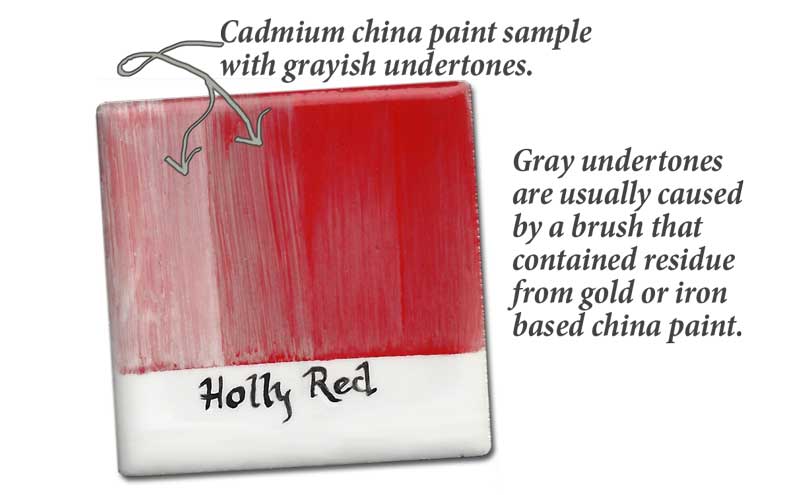


Generally speaking, the gold colors are, pinks, rubies and purples. They can be fired in an electric kiln at higher temperatures and generally do not burn out when fired and can be fired at a higher temperature than iron and cadmium china paint. Gold based colors contain gold and tend to cost a little more than iron and cadmium based colors. Iron colors are yellows, blues, greens, browns, grays and black. An exception to the rule is Violet of Iron. Generally, the iron reds are the yellow reds, blood red and dark red. These reds do not fire looking like the brilliant reds that we associate with the winter holidays. The iron reds are less intense and look almost brown after firing because they contain iron. I have fired these reds too hot and learned that they turn varying shades of brown red or brown which might not be appealing when painting subjects like apples and cherries. It is possible to achieve a holiday red by painting two coats of yellow red and a coat of blood red and firing in between each coat of paint. Another beautiful red can be achieved by mixing one half American Beauty with one half Pompadour Red or one half American Beauty and one half Blood Red. This mixture is wonderful for painting holiday and victorian themes and works great with other paintings that require a deep rich red. The American Beauty/Blood Red is one of my favorite china paint mixtures. This category is comprised of colors that might contain some iron and many that do not contain iron. Also this category includes paint that might be contain of an assortment of colorants and varying ratios of flux. Some of the iron colors in this category are modified with colorants such as manganese or zinc chromate that make up varying shades of red and brown china paint. There are iron colors that originate from iron bearing clay soil. Examples of paint from iron bearing clays would be umber or sienna. Some of the colors in this category are less problematic when they are mixed together with other china paint than mixing china paints with colors that contain pure red iron oxide. Some black china paint may contain black iron oxide, yellow china paint may contain ochre or yellow iron oxide. Many greens, blues, yellows, greys and browns do not contain iron. Yellow can be the wild card or exception to the rule. As a general rule I tend to paint with Mixing Yellow as it has been the most reliable yellow on my pallet when mixing with other colors. If using yellow, test fire alone and as a mixture with other colors. In summary, iron colors mix well with iron colors, gold colors mix well with gold colors. There are exceptions. For instance, some gold colors and iron colors will mix and get along throughout the firing process. I continue to be surprised by color combinations and like to test fire experimental color combinations before applying china paint to artwork. This is a category of colors that should be stored on a separate pallet. It is best to isolate cadmium based paints from the iron based, gold based and everything else colors. If you decide to keep all of your china paints on one pallet, cadmium colors can reside with your iron and gold based colors, however, be mindful of the possibility of mixing a cadmium color with a gold or iron based color during your painting sessions. I learned about cadmium based china paint the hard way. It is easy to be lured by colors labeled as Holiday Red, Fire Engine Red, Deep Coral, Tangerine and Bright Orange. They are beautiful and brilliant when applied to porcelain by themselves or when mixed with each other. However, they do not mix well with iron and gold based and some of the everything else colors and might cause a symptom called “firing out”. This means disappearing colors on a painting after firing because cadmium and a gold based or iron based color was combined or overlapped by a cadmium based color. Sometimes the combination will test fire well and even fire perfect, but why take the chance? As a general rule, keep the cadmium colors on a separate pallet and in separate areas on your painting. They can be painted next to iron, gold and miscellaneous china paint, just avoid overlapping. Some painters go as far as to use a set of separate brushes and brush cleaner for cadmium based colors. Above is an example of a cadmium color painted with a brush that contained gold or iron residue on the bristles. Notice the grey cast in the paint. Although the brush was thoroughly cleaned and showed no signs of lingering paint, the gray undertones appeared after firing in the kiln. Now when using Cadmium based colors I use a brush cleaner that is dedicated to the Cadmium based color pallet and also use a separate set of brushes and plan the use of a cadmium color before adding it to a painting. A good practice exercise is to use cadmium colors by themselves. Santa Claus, berries and candy canes are a good subjects to practice while getting acquainted with cadmium based china paints. Also, I have experienced good results with Mixing Yellow and Cadmium colors but not always. Dallas China Company and Maryland China Company stock Mixing Yellow. Often, you will find china paint featured exclusively by an artist with a catchy name. Keep in mind that there are very few producers of china paint throughout the world. Most of the china paint offered by artists are also offered by the larger suppliers. By test firing your colors, it is possible to find identical paint colors with different names. This is not an unethical practice, however, it is is a marketing technique. For instance, in the printing industry, Pantone produces ink colors and may offer the color Merlot and another ink supplier might offer the similar or same color as Deep Dark Wine. For this reason, I like to test fire colors on a chard of porcelain and label with the color name and the supplier. Sometimes, after test firing, I find paint vials that are identical in color but differ in name. Another scenario is some china paints might have the same name but variations in color. The only way to be sure about how your color will look on a painting is by test firing on a chard of porcelain. If I am working with glass paint, I test fire the colors on glass. When purchasing paints, always ask the seller about the paint and find out if it is gold, iron or cadmium. When using cadmium colors, I like to paint and fire the cadmium colors last when they are used on a porcelain or glass piece that contain iron or gold based paint. Also fire the cadmium colors at a lower temperature. If you are buying second hand china or glass paints always test fire. I have purchased used paints and found that the label on the vial and the contents inside differ from the name. I tend to fire the gold and iron colors hot, in the range of Cone 015 to Cone 014 or (1480 Degrees) Cadmium colors need to be fired cooler in the range of Cone 019, 018 or 017. Test firing these colors in your kiln will acquaint you with the proper temperature range for your paint. In summary, paint with your gold and iron colors early in the painting process. Often a china painter will paint with the gold colors first and then add the reds later in the painting process so that the final painting can be fired at a lower temperature to set the red. Cadmium would be added last and not as an overlapping color onto a gold based or iron oxide color so that it doesn’t cause colors to disappear or burn out.
Above are examples of iron based china paint colors.
Iron Reds and Iron Colors
 © 2010-2021 Mary Lou LaBerge
© 2010-2021 Mary Lou LaBerge